In early February, Hitachi added to their line of enterprise SSDs with the Ultrastar SSD400S.B. Following on the heels of the original SSD400S, the .B is the industry’s first to move to 25nm SLC NAND. Structurally, the two drives are nearly identical, it’s simply a NAND die change from 34nm SLC to 25nm SLC. Both drives leverage a 6 Gb/s SAS interface and Intel NAND with a Hitachi/Intel co-developed firmware and controller. The SSD400S.B takes over flagship enterprise SSD status for Hitachi and sits alongside their eMLC Ultrastar SSD400M offering.
As noted in some detail in our SSD400M review, the Hitachi/Intel partnership around these drives is a model for success. Hitachi was able to leverage their storage knowledge and IP, especially around the SAS interface, while Intel brought srtong firmware engineering and flash management technologies to the table. The results as we’ve seen have been very good. In this case the SSD400S.B addresses the leverages the partnership to deliver high throughput storage for high mixed workload (read/write) enterprise environments.
From a performance perspective, the SSD400S.B is poised to deliver sequential reads up to 536MB/s, writes of 502MB/s and random 4K read IOPS of 57,500 and write IOPS of 25,500. Beyond single drive performance, Hitachi also offers proprietary power loss management and robust endurance. The 400GB SSD supports up to 35PB of random writes over the five year life of the drive which equates to 19.2TB of writes per day. Hitachi also lists an incredibly-low annual failure rate (AFR) of 0.44%.
The Ultrastar SSD400S.B SSDs are available in 100GB, 200GB and 400GB capacities in a 2.5" form factor and carry a five year warranty.
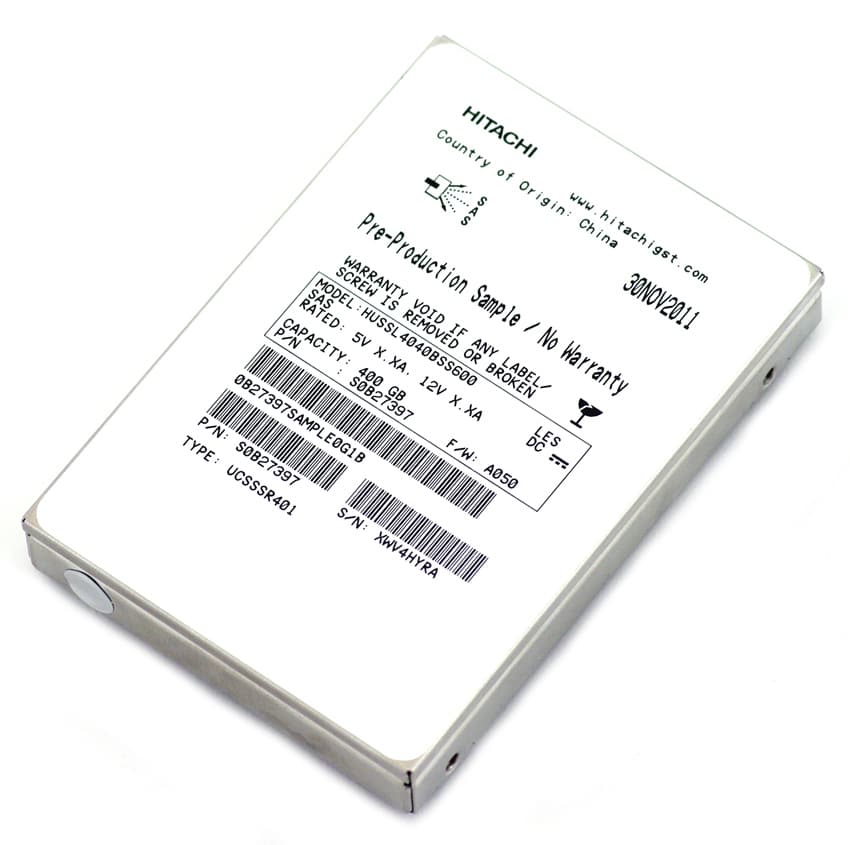
Hitachi Ultrastar SSD400S.B Specifications
- Capacities
- 400GB
- HUSSL4040BSS600
- HUSSL4040BSS601 with TGC encryption
- 200GB
- HUSSL4020BSS600
- HUSSL4020BSS601 with TGC encryption
- 100GB
- HUSSL4010BSS600
- HUSSL4010BSS601 with TGC encryption
- 400GB
- Interface – Dual Port SAS 6Gb/s
- Intel EW29AA31AA1 Controller
- Intel single-level cell (SLC) 25nm NAND x 40 (736GB Raw, 400GB Usable)
- Micron DDR2 SDRAM Cache
- Form Factor – 2.5-inch, 15mm z-height
- Transfer Performance
- Read Throughput (sequential 64K) – 536MB/s
- Write Throughput (sequential 64K) – 502MB/s
- Max Read IOPS (random 4K) 57,500
- Max Write IOPS (random 4K) 25,500
- Endurance (random write):
- 400GB Capacity – 35PB
- 200GB Capacity – 18PB
- 100GB Capacity – 9PB
- Error rate (non-recoverable bits read) 1 in 1016
- MTBF – 2.0 million
- Power
- Operating (W, typical) 5.5
- Idle (W) 1.7
- Power consumption efficiency (IOPS/Watt) – 8,360
- Five Year Warranty
- Dimensions (width x depth, height mm) – 70.1 x 100.6 x 15
- Weight (max) – 222g (400GB)
- Ambient temperature 0 to 60ºC
- Shock (half-sine wave) 1000G (0.5ms), 500G (2ms)
- Vibration (Random G RMS) – 2.16, all axes, 5 to 700 Hz
Design and Disassembly
The Hitachi Ultrastar SSD400S.B has a smooth stainless steel body, stamped into the precise shape of a 2.5-inch drive with a 15mm height. On top the drive is finished with a single white sticker that takes up the entire top surface, describing the drive down to the certifications and firmware revision. The bottom includes additional stickers, reiterating the drive’s serial number and part number. The body is rather basic and clean from the outside, with a hefty weight of 205 grams, much of which is related to internal thermal dissipation. With open-air datacenter cooling designs in mind (using outside air instead of cooled or conditioned air) and a general push to reduce energy costs associated with cooling, Hitachi gives the Ultrastar SSD400S.B a 70C / 158F maximum operating temperature.
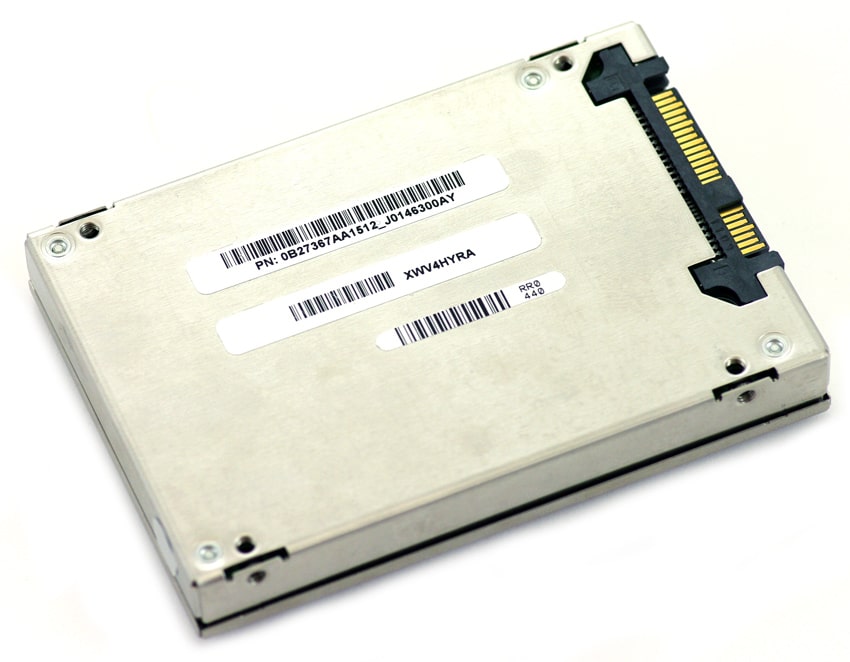
The side profile of the drive clearly shows the two sections that make up the body of the SSD400S.B. Hitachi uses industry standard screw locations on the side and bottom of the SSD for vertical or horizontal mounting.

The front of the Ultrastar SSD400S.B includes just the dual-link 6.0Gb/s SAS connector, with no additional connections visible from the exterior of the drive.

Opening up the drive shows off some of the thermal dissipation features of the Ultrastar SSD400S.B and explains where some of the drive heft comes from. The top and bottom covers both feature thick thermal pads to draw heat off key components of the SSD. The top cover includes an added heatsink to further increase the amount of energy the case body can absorb off the internal circuit boards that heat up during heavy usage. The design of the SSD is in two parts, with the controller facing inwards between each circuit board. The white pad on the bottom section of the case is designed to pull heat away from the underside of the controller, with the pink thermal pads aimed at the NAND pieces. The body is made as flat as possible on the exterior, to allow for greater surface contact with drive bays to shed thermal energy into the server case and eventually out through forced air cooling.
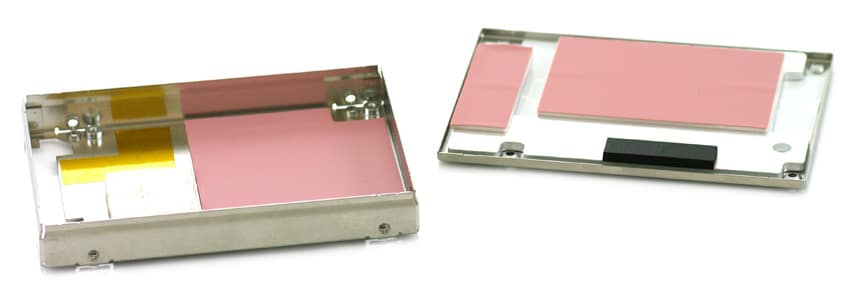
At the heart of the Hitachi Ultrastar SSD400S.B is an Intel EW29AA31AA1 processor, using firmware co-developed by Hitachi and Intel. For cache the SSD400S.B uses four Micron SDRAM memory pieces.
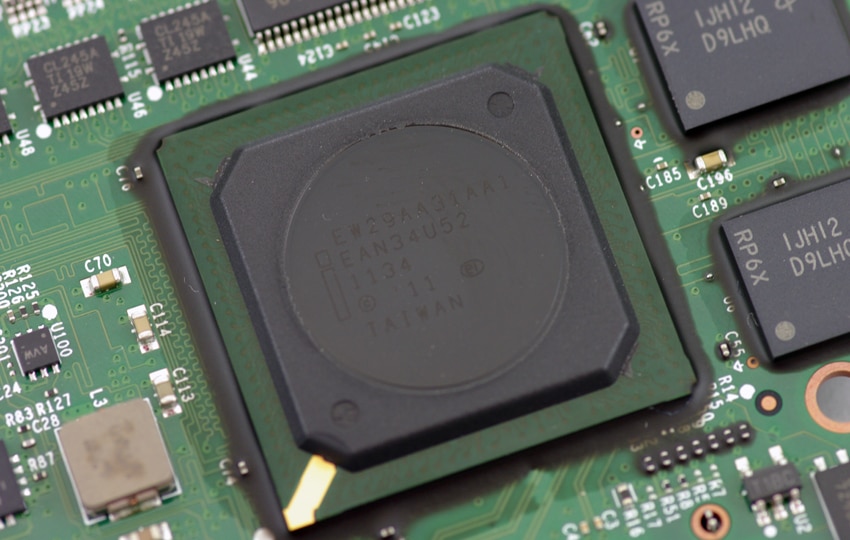
Spread out over both circuit boards are 40 pieces of Intel SLC NAND. This is divided between 34 pieces of 16GB NAND and 6 pieces of 32GB NAND. These give it a total of 736GB of raw NAND, although only 400GB is usable. This reserved space is used for background garbage collection, wear-leveling, and handling die-failures in a way that won’t slow down or disable the drive during its lifetime.
The inward-facing sections of the circuit board include the Intel EW29AA31AA1 controller, additional NAND, as well as the long interface that connects both halves of the SSD.
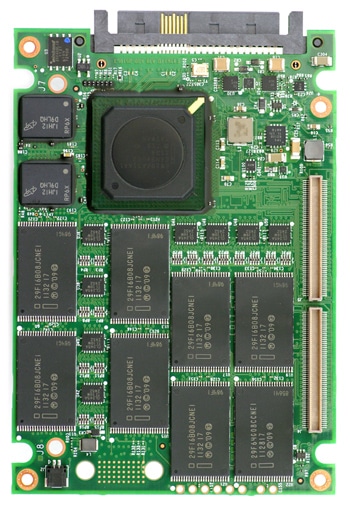
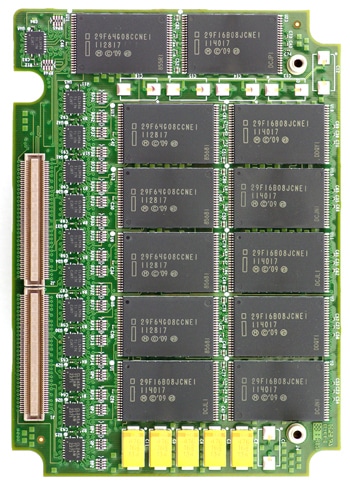
Shown below are the two outside-facing sections of the Hitachi Ultrastar SSD400S.B.
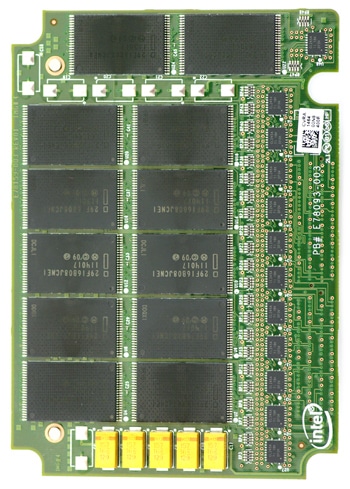
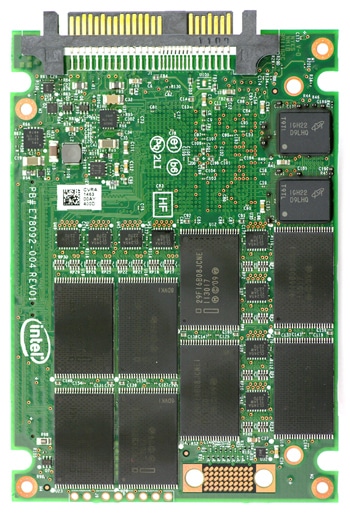
Note that this SSD design doesn’t make use of ultra-capacitors. Instead, Hitachi went with ten tantalum-based KEMET Organic Capacitors (KO-CAP). These capacitors have a longer lifespan and don’t expand or otherwise degrade as quickly as other alternatives. A similar setup was found on both the consumer-grade Intel SSD 320 and the enterprise-grade Intel SSD 710.
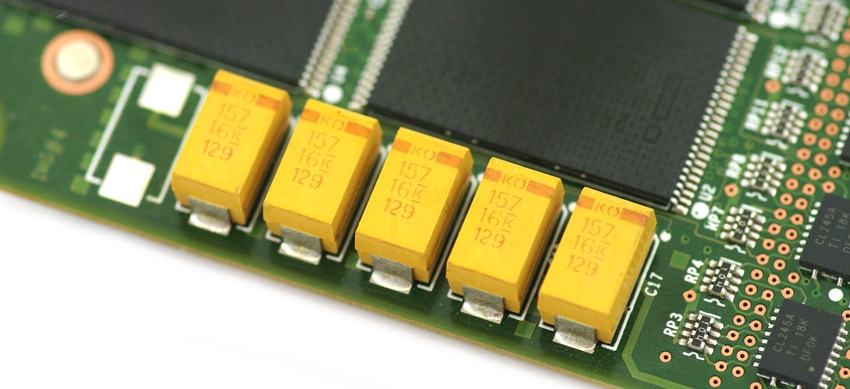
These capacitors give the drive enough time to flush SDRAM to NAND, although the actual amount of holdup time is not specified.
Enterprise Benchmarks
The Hitachi Ultrastar SSD400S.B uses Intel 25nm SLC NAND, an Intel EW29AA31AA1 controller and a 6.0Gb/s SAS interface; our review unit is 400GB. The comparables used for this review include the following recently tested enterprise SSDs: Micron P300 (100GB, Marvell 9174, Micron 34nm SLC NAND, SATA), Toshiba MKx001GRZB (400GB, Marvell 9032, Toshiba 32nm SLC NAND, SAS) and the Hitachi Ultrastar SSD400M (400GB, Intel EW29AA31AA1 controller, Intel 25nm eMLC NAND, SAS). All enterprise SSDs are benchmarked on our enterprise testing platform based on a Lenovo ThinkServer RD240. All IOMeter figures are represented as binary figures for MB/s speeds.
Our first test looks at the speed in a sequential write environment with large block transfers. This particular test uses a 2MB transfer size with IOMeter, with 4k sector alignment and measures performance with a queue depth of 4. In this scenario Hitachi claims a maximum read speed of 536MB/s and a write speed of 502MB/s for their 400GB Ultrastar SSD400S.B.

In our large-block sequential transfer test the Ultrastar SSD400S.B had read speeds that measured 532MB/s and steady-state write speeds of 510MB/s. The read speed came in slightly below Hitachi’s estimates, but the write speed came in above listed speeds. These straight-line benchmarks put the SSD400S.B at the top of our chart.
Moving to a random access profile, but still maintaining a large block transfer size of 2MB, we start to see how performance varies in a multi-user environment. This test keeps the same queue depth level of 4 that we used in the prior sequential transfer benchmark.

With the move to random large-block transfers the Hitachi Ultrastar SSD400S.B maintained its lead in read speed, measuring 533MB/s. Its steady-state write speeds dropped to 215MB/s, still leading the pack.
Moving to an even smaller random access transfer size of 4K, we get closer to the packet size that might be found in a heavy random access environment such as a server setting with multiple VMs accessing the same array. In the first test we look at expanded 4K read performance and how it scales from a queue depth of 1 to a maximum of 64.
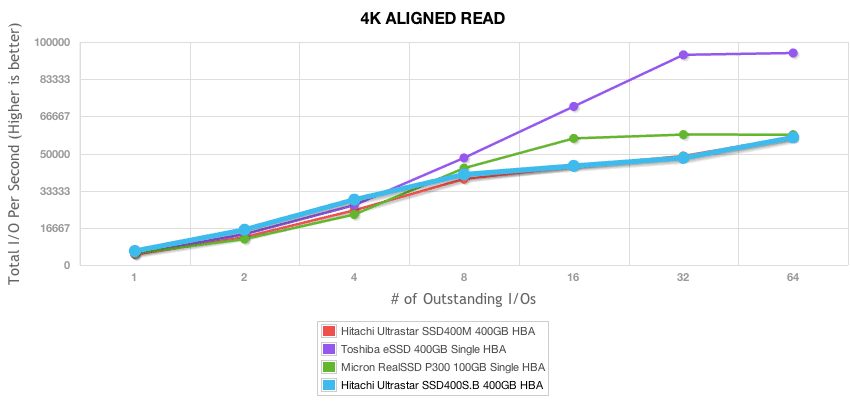
Looking at our random 4K ramped chart, we noted strong performance of the Ultrastar SSD400S.B , ranking under the Toshiba eSSD with a maximum 4K read speed of 57,217 IOPS at a queue depth of 64. Note that the SSD400S.B and SSD400M share basically the same 4K read performance profile.
Our next test looks at 4K random write performance at a static queue depth of 32 and results are recorded and averaged once the drives have reached steady-state. While IOPS performance is a good metric to measure steady-state performance, another key area of interest is around average and peak latency. Higher peak latency figures can mean certain requests can backed up under heavy continuous access.
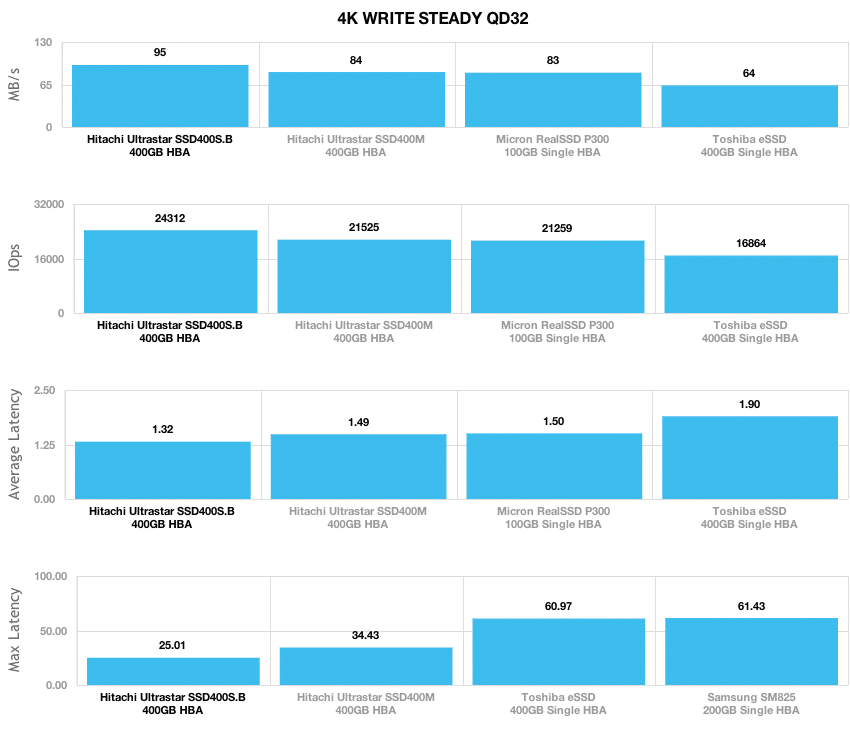
Hitachi claimed a peak 4K random write workload speed of 25,500 IOPS, which we found to be 24.312 IOPS in steady-state in our testing. This speed ranked the highest in our group, above the SLC-based Micron P300. In these conditions the Ultrastar measured 95MB/s average with an average response time of 1.32ms. The max response time was probably the most impressive though, coming in at only 25.01ms.
Our last series of synthetic benchmarks compare both enterprise drives in a series of server mixed-workloads with a static queue depth of 32. Like the synthetic benchmarks at the start of this review, these tests are also measured in steady state. Each of our server profile tests has a strong preference towards read activity, ranging from 67% read with our database profile to 100% read in our web server profile.
The first is our database profile, with a 67% read and 33% write workload mix primarily centered on 8K transfer sizes.
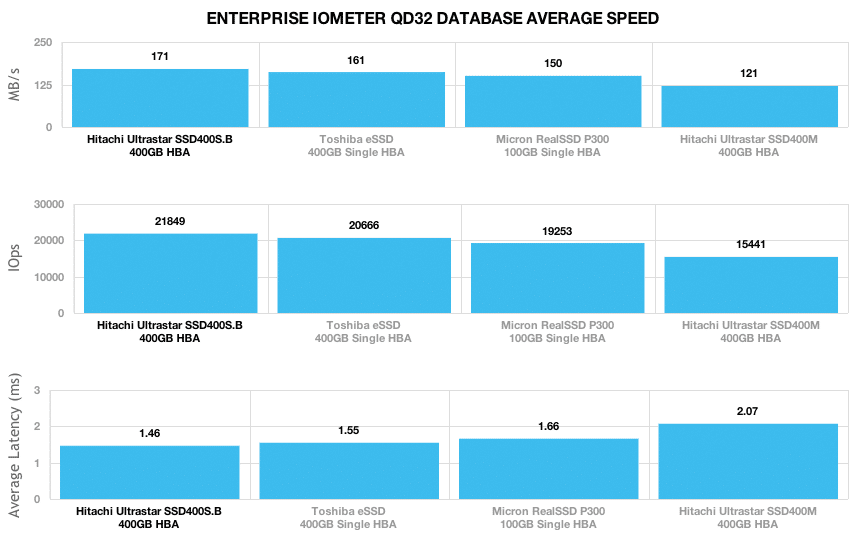
Testing with our database IOMeter profile, the Hitachi SSD400S.B led the pack, coming in above the other SLC-based enterprise SSDs that we have tested. Compared to the eMLC SSD400M that offered 15,441 IOPS, the SLC-based SSD400S.B came in with a speed of 21,849 IOPS.
The next profile looks at a file server, with 80% read and 20% write workload spread out over multiple transfer sizes ranging from 512-byte to 64KB.
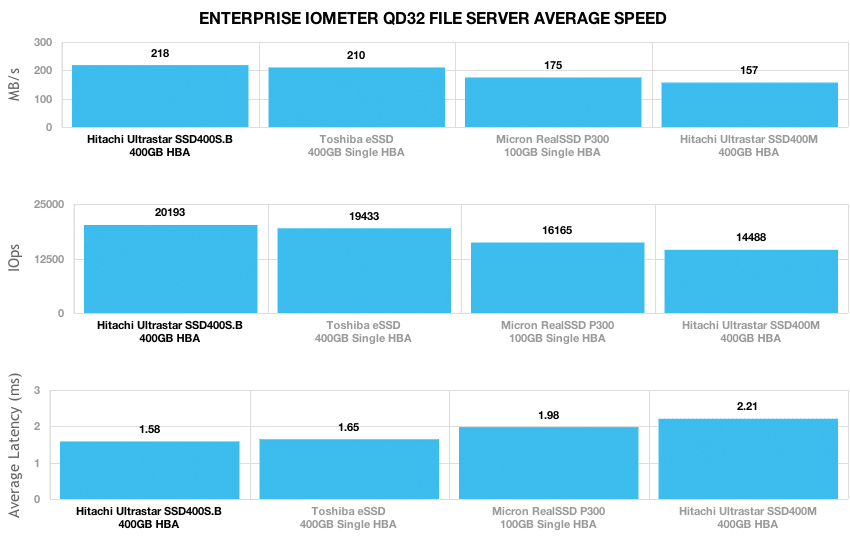
Switching to a File Server setting with a much broader mix of transfer sizes, the Hitachi Ultrastar SSD400S.B still maintained its lead, with performance measuring 20,193 IOPS, compared to 14,488 IOPS from the eMLC-based SSD400M.
Our web server profile is read-only with a spread of transfer sizes from 512-byte to 512KB.
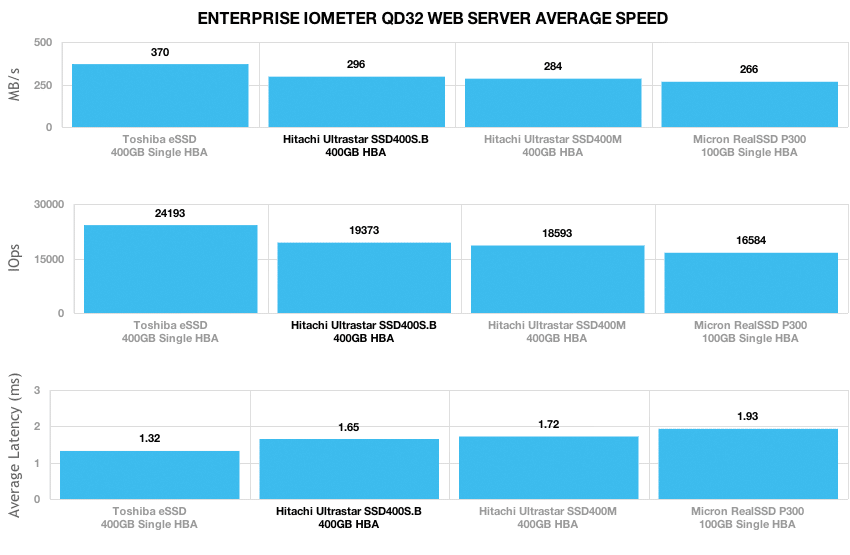
In a read-only setting, the Toshiba MKx001GRZB was able to offer higher transfer speeds, measuring 24,193 IOPS compared to 19,373 IOPS from the Ultrastar SSD400S.B or 18,593 IOPS from the eMLC SSD400M.
The last profile looks at a workstation, with a 20% write and 80% read mixture using 8K transfers.
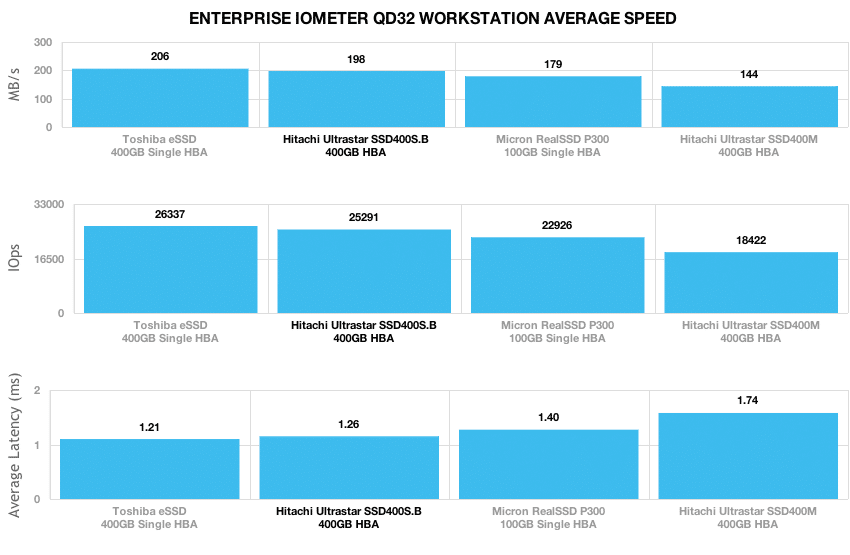
In a workstation setting, the Hitachi Ultrastar SSD400S.B came in slightly under the Toshiba MKx001GRZB, measuring 25,291 IOPS to the Toshiba’s 26,337 IOPS.
Enterprise Power Consumption
When it comes to choosing drives for the datacenter or other densely-packed storage environment, performance isn’t the only metric companies are interested in when looking at SSDs or hard drives. Power consumption can be a huge deal in certain cases, so it makes sense that you would want to know how a drive would perform under a constant workload.
In the Enterprise Power section of this review, we look at each drive under the same conditions we used to test the read and write speeds in earlier. This includes sequential and random 2MB transfers with a queue depth of 4 and small random 4K read and write transfers at a queue depth of 32. As with our previous tests we are measuring all figures in a steady-state to put the drive into its most power-hungry conditions.
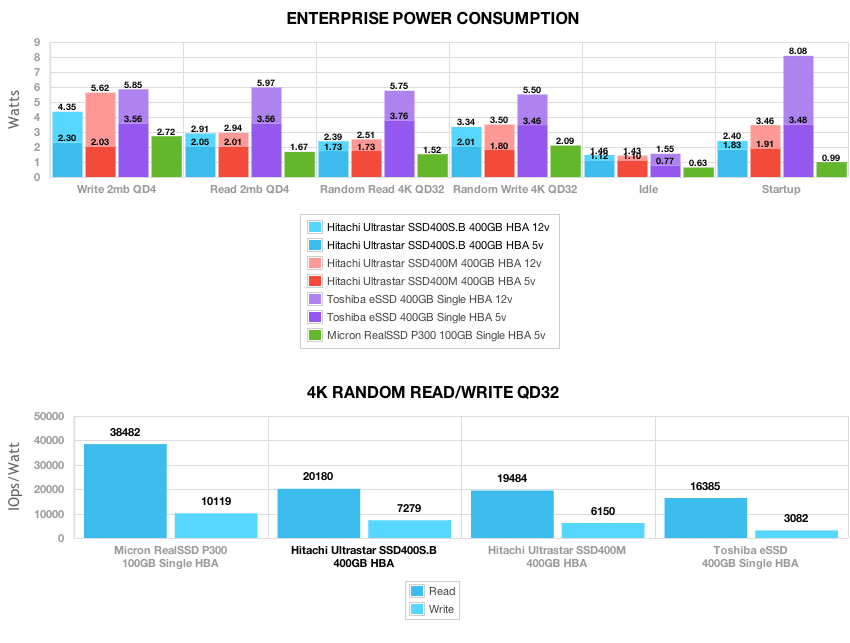
Under all conditions except start-up, the Hitachi Ultrastar SSD400S.B used 4.35 watts or less. This is less than Hitachi’s own eMLC-based SSD400M. The most power hungry activity for the SSD400S.B was sequential QD4 2MB write, using 4.35 watts averaged over the duration of the test. Second was random 4K QD32 write using 3.34 watts, third was sequential QD4 read using 2.91 watts followed by 4K QD32 steady read coming in fourth needing 2.39 watts.
While a large push for an eMLC SSD in a datacenter environment is around cost per GB and IOPS/Watt, there is still a need for high-endurance and high-performance SLC-based models. We calculated a figure of 20,180 IOPS/watt in pure random 4K read at a queue depth of 32, dropping to 7,279 IOPS/watt if you instead look at steady 4K random write. This compared to 38,481 IOPS/watt read or 10,119 IOPS/watt write on the SLC Micron P300 or 16,385 IOPS/watt read, 3,082 IOPS/watt write on the SLC Toshiba MKx001GRZB. It really comes down to the needs of the business, finding the best blend of power to performance (or just straight performance) that factors in when buying the SSD or hard drive.
Conclusion
We had pretty high expectations when reviewing the Hitachi Ultrastar SSD400S.B, given how well the eMLC SSD400M performed. We expected the new SLC-based Intel/Hitachi collaboration to be even better and the SSD400S.B didn’t disappoint. The enterprise SSD took the top spots in many of our benchmarks with a mixed read/write workload. It also performed very well in our large-block random and sequential read/write tests and our 4K random write steady-state test.
When looking at its performance in all areas, it fell back slightly in the read-only Webserver setting and our ramped 4K read test, where the Toshiba MKx001GRZB took top position. The Hitachi did offer more balanced performance throughout though. Given the high-endurance SLC NAND, we would expect to see this drive used in scenarios with heavy write activity over the lifespan of the drive. Hitachi rates the Ultrastar SSD400S.B to last between 9PBW to 35PBW depending on capacity.
Just like the eMLC iteration, we see clear benefits of the Intel and Hitachi collaboration. Intel delivers a time-tested SSD controller and plenty of NAND knowhow and Hitachi provides their deep understanding of storage including the SAS interface. The combined effort is special, making the SSD400S.B one of the premier enterprise SSD offerings to date for heavy use environments that need to support heavy read and write performance.
Pros
- Strong mixed workload performance
- Better power consumption than eMLC-based Ultrastar SSD400M
- Great 4K steady-state speed
- Designed to work in a wide thermal envelope
Cons
- Weaker than Toshiba MKx001GRZB in our ramped 4K test and read-only Webserver test
Bottom Line
The Hitachi Ultrastar SSD400S.B offers terrific mixed workload performance, scoring at or near the top when compared to other SLC enterprise SSDs. Toss in the set of enterprise SSD features, drive heritage, and low power consumption and Hitachi posts a well-rounded offering ready for heavy enterprise use.




 Amazon
Amazon